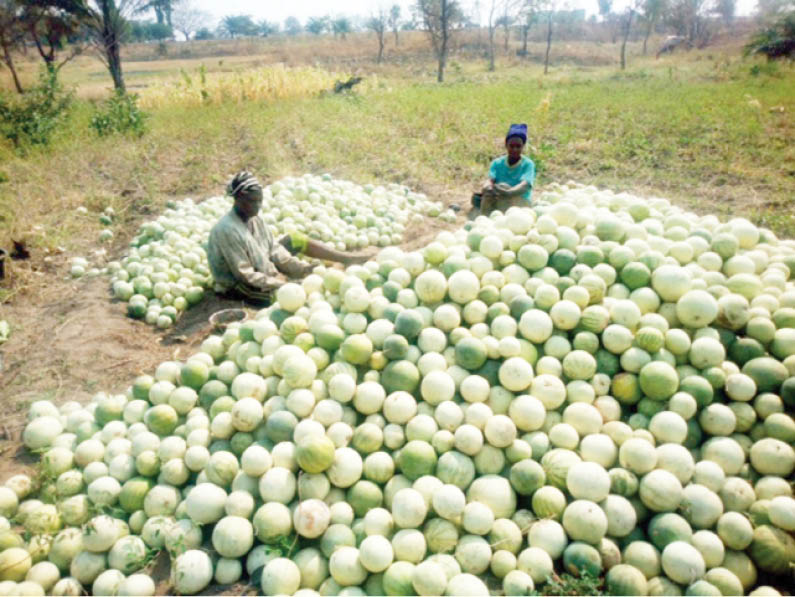Egusi melon, botanically called Citrullus colocynthis, also has many names such as colocynth, bitter apple, bitter cucumber, desert gourd, vine of Sodom, or wild gourd.
Although egusi is consumed in Nigeria, the cultivation hardly attracts any significant attention and even government has not developed any programme to promote its inherent potentials to hugely improve the household income in poor communities.
At the moment, only sesame can compete with the product in the market. Ten 170kg bags of egusi will give a farmer between N900,000 and N1.1 million under the current market price depending on the market location.
Cheap to produce, expensive in the market
A Seed Systems Principal Investigator in Federal University of Agriculture, Makurdi (FUAM), Teryima Iorlamen, in an interview with our correspondent explained that the cost of production of melon is cheap but the product is very expensive in the market.
Iorlamen emphasised, “A bag of melon is now N100,000. Melon products are extracted for oil and soup making while the chaffs are used in place of firewood.
“Melon is one of the most expensive products yet the cheapest crop to grow. If a farmer wants to become a millionaire in a few years, he should go into melon production. The only challenge of melon is that it is not a water-loving crop. The reason is that when there is high moisture in the soil, it builds up pest infestation. The challenge of melon is insects that attack it.
“That is why some people believe that melon is not for every year; meaning that, if you planted in 2018, then, 2019 would not be the year for melon until 2020. It also means that in 2018 when melon was planted, a provision for food for its insects had been made so they will multiply such that the following year, the number of insects in that field will not allow the farmer to gain anything if he plants it. So farmers allow one year to fallow so that those insects would be suppressed and die before they go back into the field again,” he added.
Iorlamen, however, explained that if the farmers have a way of controlling the insects/pests, they can grow their melon every year.He advised that if farmers are planting melon, they must be ready to spray chemical against insects, pest and diseases otherwise they wouldn’t get anything because the newest varieties of melon are sweet and succulent so they are more prone to attacks than even the old ones.
Why some farmers ignore it
For many commercial farmers, it is still a crop for the smallholder farmers because it is difficult to cultivate in hundreds of hectares as there is no mechanization available in the country to deploy for harvest.
Secondly, hitting or slicing it to allow for fermentation before removing the seed, washing, and sun-drying is what some farmers consider tedious.
But the chairman of Melon Farmers Association in Benue State, Elder Joshua Agan, believes that many people are not aware of the value of growing melon.
He said the 65-member association had concluded arrangement to organise a programme which would create awareness for more farmers to key into the production.
“A lot of people don’t know the advantages of melon and why it is very expensive in the market. The melon product is used as engine oil for aircraft,” Agan stated.
Some farmers already reaping benefits
Pa Hule grows melon in the dry season.He told our correspondent that the cost of production was quite minimal compared to the rice he harvested from the same spot before planting the melon and he expects to earn a good income from the product when sold it.
“This is dry season melon. I planted the crop after harvesting maize and rice from this portion of the farm around ending of October 2018. I think the harvest is good,” Hule said.
Gomna Yusuf, an undergraduate farmer, said he concentrated in melon because there bags, when sold,were enough to take care of his school fees, and other expenses in school, adding that melon farming doesn’t incur much expenses and therefore doesn’t need much capital to start.
“In 2017, we sold a bag at N120,000 per 170kg and three bags gave me N360,000. My school fee was N42,000. I don’t need to beg for resources to go to school,” he said.
Gomna advised that herbicide and pesticides should be applied three weeks after sowing for effective management of weeds.
The planting period
He also said that “There are two periods of planting melon in Benue, the foremost is during the first rain so that before the rains are full in July, the farmers would almost be harvesting and the second period is when people commence planting around October, when the rain would be exiting.
“Melon needs rain for only 30 days and maximally, 40 days. It produces better quality with less rain and that’s why the melon being harvested now (January/February) is better in quality than the ones harvested in July/August. Melon is a drought resistance crop.
“For instance, a melon of 1kg can produce 4 bags and 4kg of melon planted can as well produce over 10 bags,” he said.
Experts said melon does not need excessive water, adding that its major challenge during production remained insects attack and that’s why the crop was not for every year production.Farmers often allowed one year to fallow before they go back to their farms to plant melon again, he pointed out, adding that the crop does not require much fertiliser because it is a low feeder.
Seed rate and spacing
Some farmers who have been in the cultivation for years advise two seeds per hole and three seeds in areas prone to disease attack.
In terms of spacing, Ayodele, Olufemi and Salami, Ayodeji in their study of physiological response of two variants of egusi melon to plant population density in a humid environment said the two varieties (Bara and Serewe) produce “slightly more fruits at 2m x 2m, which is preferred for sole cropping, in view of its rectangularity. The 1m x 4 m spacing can be adopted for egusi planted as a component in yam or cassava established on 1m ridges.”

 Join Daily Trust WhatsApp Community For Quick Access To News and Happenings Around You.
Join Daily Trust WhatsApp Community For Quick Access To News and Happenings Around You.


